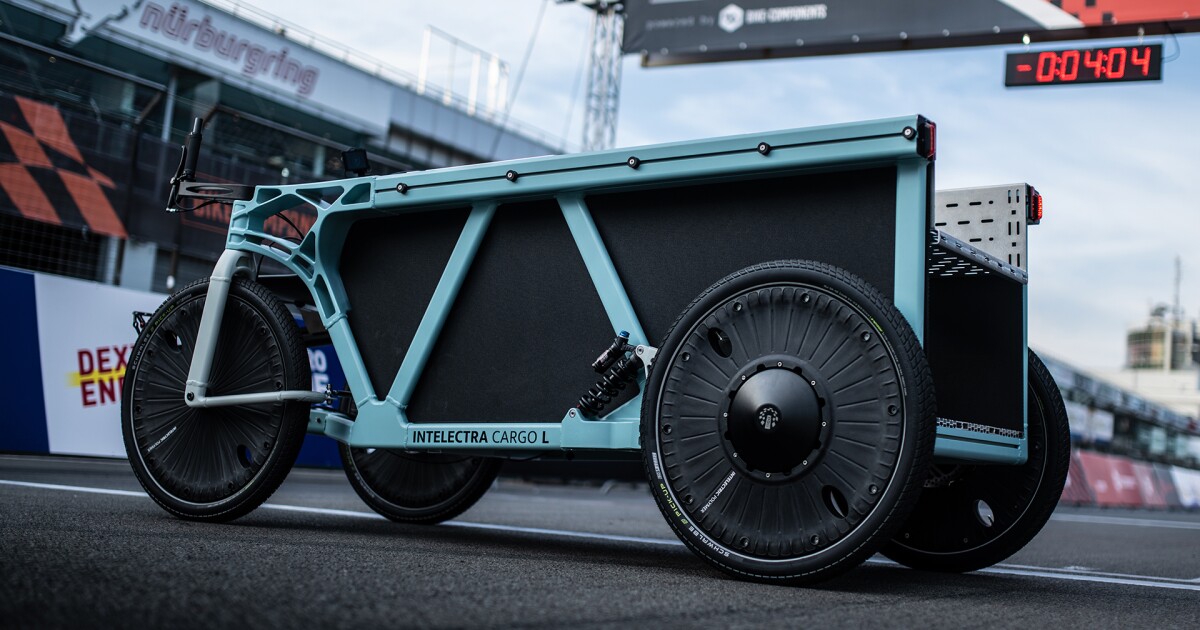As a Euro-pallet hauler, this isn’t the most absurd implementation I’ve seen so far, as it sits low and has the rider in a recumbent position and is non-articulating. This would tend to make it harder to lose control when carrying a large payload (ie a trailer wagging across the road).
On the other hand, the lack of a direct chain, belt, or gears disqualifies this from the California definition of “bicycle”, which in turn disqualifies it as an ebike under the three class system here. If it weren’t for that, this four-wheel ebike would be legal here; other jurisdictions will vary.
But I think we need to address the elephant in the room: hauling 454 kg is well in excess of what would constitute normal bicycle or ebike traffic. A while ago, I had a thread discussing when the “micro” in micromobility ends, and I think this definitely crosses the boundary into commercial goods-hauler.
Not to say it shouldn’t exist: I can see this perfectly serving the role of last-mile delivery to restock urban shops. But this shouldn’t be ridden on bike trails or through parks, and instead should keep to street-adjacent bike lanes along existing commercial delivery routes. The benefit to distributors would be the ability to squeeze past automobile congestion. The faster-than-25-kph-version properly deserves to be regulated as an electric scooter, but the 25 kph model can plausibly coexist with motor vehicles on 30 kph (~20 mph) urban streets.
In short, if this goods-hauler can operate on existing roads and displace delivery motor-vehicles, great! But if it can only work by appropriating space on bike paths and other pedestrianized spaces, that’s not good.
Seems like a bad idea to fill bike lanes with delivery vehicles.
Great for personal use.
Its like the i3 with rex (“range extender”) - an electric car with petrol engine generator.
But a bike.I really like the concept (& I’ve been waiting for such thing to pop up in usable form in cargo bikes).
It’s used in boats, ships, and other heavy machinery, but with internal combustion engines.This is the delivery service vehicle cities need. The operator paddles the generator continuously and independently of traffic or if moving, and on their own terms (how/when hard/fast).
Of course, it’s not solely leg power that drives the 270-lb (122-kg) Intelectra truck-cycle forward. In fact, leg power doesn’t drive it directly at all.
Instead, the rider’s pedaling power gets converted into up to 250 Watts of electrical power by a generator between the cranks. This nominally charges the 1,400-Wh+ battery that directs power to the pair of 125-W rear hub motors. The rider’s pedaling strength and cadence control the motor output via an intelligent multi-controller system so that pedaling harder still makes the quad move faster, but it’s all electronically operated.
How in the hell is that efficient?
The standard Intelectra does not include a throttle for non-pedaled acceleration, and thus classifies as a pedelec bike with a top speed of 15.5 mph (25 km/h). Dynamic Drives says that it can equip the rig with a throttle for customers who request one, but that pushes it into the electric scooter category, requiring registration, license plates and a driver’s license to operate legally.
Yeah, the pedals have got to be solely due to regulations.
It’s definitely less efficient than a standard well-tuned bike. On the other hand, I’m guessing you can plug it in to charge the battery and so you the rider don’t need to supply all of the energy to drive the thing. Plus it’s going to be excellent for hills because you don’t need to supply all the climbing power. If this were a pure manual crank vehicle you would absolutely hate it on the first hill! Pedaling 1200lbs up a hill sounds like an absolute nightmare!
No doubt. But it’s pretty unusual compared to pedal assist. With pedal assist, your leg work doesn’t lose any power in the transfer to the wheels, and you still get all the benefits of this system.
Perhaps the reason they didn’t go with pedal assist is due to the sheer amount of torque needed to pull that much weight. I could see them not wanting to have a huge gear train to be able to get the pedal power into the correct part of the torque band to both accelerate and maintain pulling power.
The pedals are additionally used as a controller to engage the electric motor & make it move (because that is “the electric bike”).
And one can still paddle without moving just by holding the brakes (to just fill the battery).The pedals are still needed to generate power for the battery, regardless if the paddling motion also activates the electric motor (electric bike) or not (electric scooter).
deleted by creator
deleted by creator
I see a legal issue. Is it still an electric assist bike or full electric …4-wheeler?
Yeah, maybe someone can explain to me how this isn’t a vehicle at this point. Sure, it’s smaller, but having a 1000 pound vehicle using bike paths and multi-use paths seems dangerous. This feels like someone trying to pass off a small car as a bike in order to circumvent safety standards more than being a real form of micro mobility.
Yeah, I am worried about how well the brakes will work on that when fully loaded, those are some skinny tires…
Getting closer to 1,500 if you include the cargo, rider, and bike
That’s addressed in the article. Pretty absurd design though, surely a chain is more efficient.
it’s electric. it mentions in the article that it’s not directly powered by legs at all (directly anyway)
it has a pair of ~150w rear hub motors, class 2 too speed of 15mph and a range of 35-45 miles.
pretty neat overall considering it’s load capacity.




